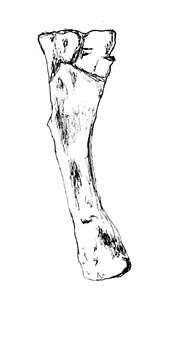Dystrophaeus
| Dystrophaeus Temporal range: Late Jurassic, 155.7 Ma | |
|---|---|
 | |
| D. viaemalae ulna | |
| Scientific classification | |
| Kingdom: | Animalia |
| Phylum: | Chordata |
| Class: | Reptilia |
| Clade: | Dinosauria |
| Order: | Saurischia |
| Suborder: | †Sauropodomorpha |
| Clade: | †Eusauropoda |
| Genus: | †Dystrophaeus Cope, 1877 |
| Species: | †D. viaemalae |
| Binomial name | |
| Dystrophaeus viaemalae Cope, 1877 | |
Dystrophaeus is the name given to an extinct genus of eusauropod dinosaur from the early Kimmeridgian stage of the Late Jurassic that existed around 155.7 Ma.[1] Its fossils were found in the Tidwell Member of the Morrison Formation of Utah. Its estimated mass is 12 tonnes (13 short tons).[2]
The type species, D. viaemalae, was described by Edward Drinker Cope in 1877.[3] The genus name means "coarse joint" from Greek dys, "bad", and stropheus, "joint", a reference to the pitted joint surfaces serving as an attachment for cartilage. The specific name reads as Latin viae malae, "of the bad road", a reference to the various arduous routes taken to find, reach and salvage the remains. It consists of one partial skeleton, the holotype USNM 2364, which includes a 76 centimetre long ulna, a scapula, a partial radius, and some metacarpals discovered in August 1859 by John Strong Newberry. It was found in what is possibly stratigraphic zone 1 of the Morrison,[4] although an older Oxfordian-Callovian has also been suggested. Dystropheus represents one of the oldest discoveries of sauropods in America; earlier, in 1855, some teeth had been found of Astrodon.
The classification of Dystrophaeus has been rather confusing. Cope in 1877 merely concluded it was some Triassic dinosaur. Henri-Émile Sauvage in 1882 understood it was a sauropod, assigning it to the Atlantosauridae. Othniel Charles Marsh however, in 1895 stated it belonged to the Stegosauridae. Friedrich von Huene, the first to determine it was of Jurassic age, in 1904 created a special family for it, the Dystrophaeidae, which he assumed to be herbivorous theropods.[5] Only in 1908 von Huene realised his mistake and classified it in the sauropod Cetiosauridae, refining this in 1927 to the Cardiodontinae. Alfred Romer in 1966 put it in the Brachiosauridae, in a subfamily Cetiosaurinae.
Finally, a modern analysis by David Gillette concluded it was a member of the Diplodocidae.[6][7] However, many researchers consider the taxon to be a nomen dubium.
References
- ↑ Turner, C.E. and Peterson, F., (1999). "Biostratigraphy of dinosaurs in the Upper Jurassic Morrison Formation of the Western Interior, U.S.A." Pp. 77–114 in Gillette, D.D. (ed.), Vertebrate Paleontology in Utah. Utah Geological Survey Miscellaneous Publication 99-1.
- ↑ Foster, J.R. (2003). Paleoecological Analysis of the Vertebrate Fauna of the Morrison Formation (Upper Jurassic), Rocky Mountain Region, U.S.A. New Mexico Museum of Natural History and Science:Albuquerque, New Mexico. Bulletin 23.
- ↑ E. D. Cope, 1877, "On a dinosaurian from the Trias of Utah", Proceedings of the American Philosophical Society 16: 579-584
- ↑ Foster, J. (2007). "Appendix." Jurassic West: The Dinosaurs of the Morrison Formation and Their World. Indiana University Press. pp. 327-329.
- ↑ F. v. Huene, 1904, "Dystrophaeus viaemalae Cope in neuer Beleuchtung", Neues Jahrbuch für Mineralogie, Geologie und Paläontologie 19: 319-333
- ↑ Gillette, D.D., 1996, "Origin and early evolution of the sauropod dinosaurs of North America -- the type locality and stratigraphic position of Dystrophaeus viaemalae Cope 1877", In: Huffman, A.C., Lund, W.R., and Godwin, L.H. (eds), Geology and resources of the Paradox Basin, Utah Geological Association Guidebook, 25: 313-324
- ↑ Gillette, D.D., 1996, "Stratigraphic position of the sauropod Dystrophaeus viaemalae Cope and its evolutionary implications", In: Morales, Michael, editor, The continental Jurassic, Museum of Northern Arizona Bulletin 60: 59-68